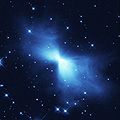Файл:Boomerang nebula.jpg

Размер этого предпросмотра: 600 × 600 пкс. Другие разрешения: 240 × 240 пкс | 480 × 480 пкс | 768 × 768 пкс | 1024 × 1024 пкс | 1590 × 1590 пкс.
Исходный файл (1590 × 1590 пкс, размер файла: 249 Кб, MIME-тип: image/jpeg)
История файла
Нажмите на дату/время, чтобы посмотреть файл, который был загружен в тот момент.
| Дата/время | Миниатюра | Размеры | Участник | Примечание | |
|---|---|---|---|---|---|
| текущий | 15:29, 19 мая 2007 |  | 1590 × 1590 (249 Кб) | Pamputt | {{Information |Description= |Source= |Date= |Author= |Permission= |other_versions= }} |
Использование файла
Следующие 2 страницы используют этот файл:
Глобальное использование файла
Данный файл используется в следующих вики:
- Использование в ar.wikipedia.org
- Использование в ast.wikipedia.org
- Использование в bn.wikipedia.org
- Использование в ca.wikipedia.org
- Использование в cs.wikipedia.org
- Использование в da.wikipedia.org
- Использование в de.wikipedia.org
- Использование в en.wikipedia.org
- Использование в en.wikiversity.org
- Использование в en.wiktionary.org
- Использование в es.wikipedia.org
- Использование в eu.wikipedia.org
- Использование в fa.wikipedia.org
- Использование в fi.wikiversity.org
- Использование в fr.wikipedia.org
- Использование в he.wikipedia.org
- Использование в hu.wikipedia.org
- Использование в hy.wikipedia.org
- Использование в id.wikipedia.org
- Использование в it.wikipedia.org
- Использование в it.wikibooks.org
- Использование в ja.wikipedia.org
- Использование в ko.wikipedia.org
- Использование в lb.wikipedia.org
- Использование в mk.wikipedia.org
- Использование в nl.wikipedia.org
Просмотреть глобальное использование этого файла.


